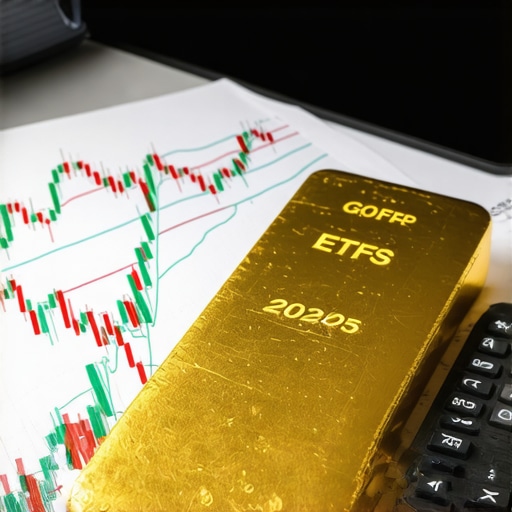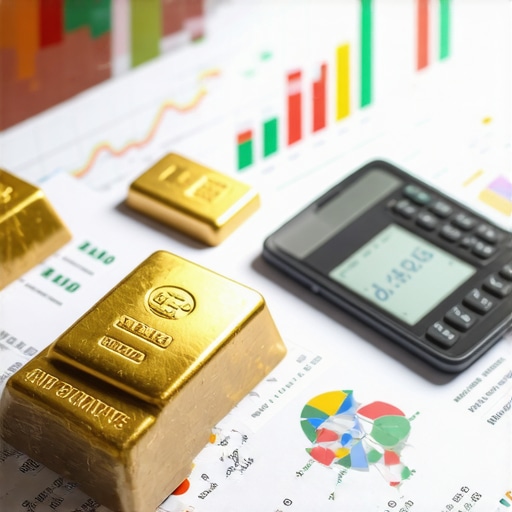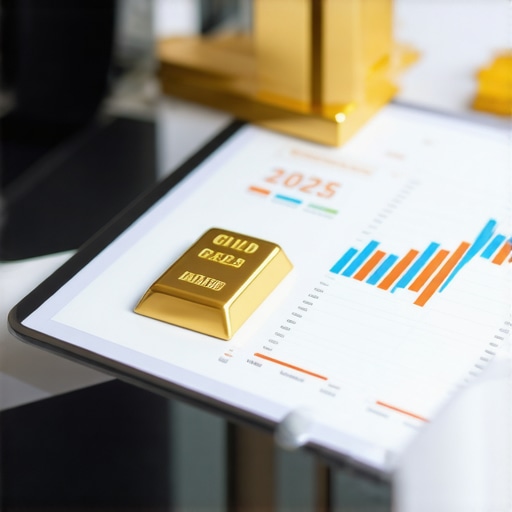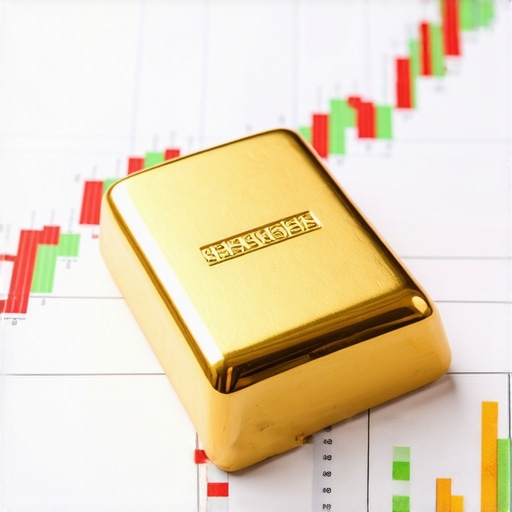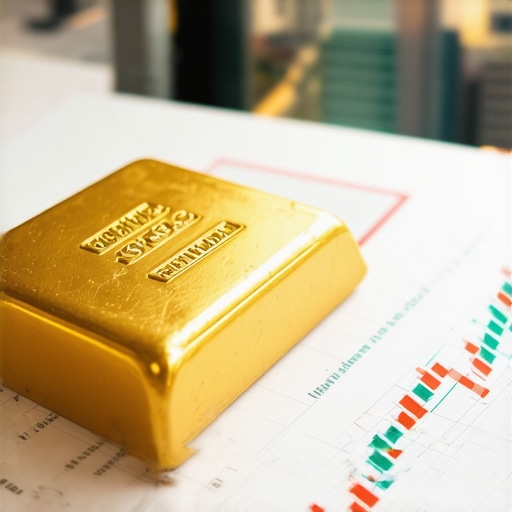Strategic Investment in Gold: The Vanguard of Portfolio Diversification in 2025
In the rapidly evolving landscape of global finance, gold remains a cornerstone of resilient and diversified investment portfolios. As we approach 2025, understanding the nuanced roles of Gold ETFs and mutual funds is essential for professional investors seeking to optimize risk-adjusted returns. Gold’s intrinsic value, combined with sophisticated financial instruments, offers a compelling avenue to hedge against inflation, geopolitical instability, and currency fluctuations.
Deciphering the Complexities of Gold ETFs and Mutual Funds for Institutional Portfolios
What are the core differences between Gold ETFs and mutual funds, and how do they influence portfolio strategies?
Gold ETFs, such as SPDR Gold Shares (GLD), offer liquidity and ease of trading, directly reflecting gold prices with minimal management fees. Conversely, gold mutual funds pool assets to invest in a diversified basket of gold mining stocks and related securities, providing exposure to both physical gold and the operational efficiencies of gold mining companies. For institutional portfolios, balancing these instruments requires a comprehensive understanding of their market correlations and volatility profiles, especially as geopolitical tensions and monetary policies evolve.
Emerging Trends: How Global Economic Factors Will Shape Gold’s Role in 2025
According to a market analysis, inflationary pressures, central bank policies, and currency devaluations are anticipated to drive gold demand higher. Moreover, advances in gold mining technology and ESG considerations are influencing fund selection criteria, favoring sustainable and responsible investment avenues. Understanding these drivers is crucial for constructing resilient investment strategies that leverage gold’s unique value proposition during economic downturns.
Expert Techniques to Maximize Gold ETF and Mutual Fund Returns in 2025
Maximizing returns involves tactical allocation and timing. Asset managers should consider deploying dollar-cost averaging during periods of volatility and employing technical analysis to identify entry points. Additionally, integrating gold derivatives and futures, as discussed in trading strategies, can enhance portfolio flexibility and hedge against short-term risks. Continuous monitoring of geopolitical developments and economic indicators will enable adaptive rebalancing, essential for maintaining optimal exposure.
How Will Central Bank Gold Purchases Influence 2025 Prices?
Central banks are pivotal in gold price dynamics. As per recent white papers, increased acquisitions by emerging markets can provide upward price pressure, especially when combined with declining mine supply. This institutional behavior underscores the importance of integrating macroeconomic analysis into asset allocation frameworks for 2025.
What are the most sophisticated strategies for integrating gold ETFs and mutual funds into a long-term wealth-building plan?
Developing a resilient gold investment strategy necessitates a layered approach, incorporating both physical gold holdings and financial instruments. Diversification across different gold ETFs and mutual funds, aligned with macroeconomic forecasts, can mitigate sector-specific risks. Portfolio rebalancing, combined with a focus on low-cost, ESG-compliant funds, will enhance overall wealth preservation and growth prospects in 2025.
For further insights, explore our comprehensive guide to building wealth with gold IRAs. Investors and professionals are encouraged to contribute their expertise and share innovative approaches to gold investment.
Innovative Techniques for Integrating Gold into Complex Portfolio Architectures
As gold continues to demonstrate its resilience amidst fluctuating global markets, sophisticated investors are exploring multi-layered approaches to incorporate gold assets effectively. Combining physical gold, ETFs, futures, and mining stocks allows for a nuanced risk management framework that balances liquidity, diversification, and growth potential. For instance, deploying a strategic blend of gold derivatives with physical holdings can hedge against short-term volatility, while long-term allocations in gold mining equities can capitalize on sector growth trends, as highlighted in developing a profitable gold portfolio.
Challenging Assumptions: Is Gold Still a Safe Haven in 2025?
Common perceptions position gold as the ultimate safe haven during economic crises. However, recent market dynamics suggest a more complex picture. The interplay between technological advancements in mining, ESG investing, and geopolitical shifts may influence gold’s stability and growth trajectory. Analyzing market analysis reveals that while gold remains a vital hedge, its performance is increasingly tied to broader technological and regulatory developments. Investors should consider these factors when constructing resilient, adaptive portfolios that leverage gold’s unique attributes without over-relying on traditional narratives.
How Can Experts Develop Dynamic Allocation Models for Gold in 2025?
Expert portfolio managers utilize advanced quantitative models to dynamically adjust gold exposure based on real-time economic indicators, market sentiment, and geopolitical risks. Techniques such as machine learning algorithms and scenario analysis enable proactive rebalancing, optimizing risk-adjusted returns. For example, integrating real-time data from market trend reports can provide actionable insights into gold’s relative valuation, guiding strategic allocation decisions. Developing such models requires a deep understanding of macroeconomic variables, gold supply-demand fundamentals, and investor behavior, making them indispensable tools for modern wealth management.
To deepen your understanding of these strategies, explore our comprehensive guide on building a profitable gold portfolio for long-term wealth. Sharing insights and experiences within the investor community can foster innovative approaches to navigating the evolving gold market landscape in 2025.
Harnessing Technological Innovations for Gold Portfolio Optimization in 2025
As the investment landscape becomes increasingly sophisticated, leveraging cutting-edge technological tools is vital for optimizing gold allocations. Advanced analytical platforms employing artificial intelligence and machine learning algorithms can process vast datasets—ranging from macroeconomic indicators to geopolitical developments—allowing investors to identify subtle market signals that precede price movements. For instance, predictive analytics can forecast short-term volatility, enabling precise timing for entry and exit points, thereby enhancing risk-adjusted returns.
Integrating ESG Criteria into Gold Investment Decisions: A New Paradigm
Environmental, Social, and Governance (ESG) considerations are transforming asset selection across all sectors, including gold. Modern investors demand transparency around mining practices, supply chain ethics, and sustainability initiatives. Incorporating ESG metrics into gold ETF and mutual fund selection not only aligns with responsible investing principles but also mitigates regulatory and reputational risks. Research from the Morgan Stanley ESG Report indicates that ESG-compliant gold funds tend to outperform their traditional counterparts over the long term, driven by increased investor confidence and regulatory favorability.
Addressing the Nuanced Question: How Do Market Liquidity and Regulatory Changes Impact Gold’s Role as a Safe Haven?
Market liquidity and evolving regulatory frameworks are complex yet critical factors influencing gold’s safe-haven status. During periods of heightened volatility, liquidity constraints can exacerbate price swings, challenging the perception of gold as a universally reliable hedge. Recent regulatory shifts—such as stricter mining standards and international trade agreements—also impact supply dynamics and market access. According to the IMF Working Paper, these changes can induce short-term dislocations but ultimately foster a more transparent and stable market environment, reinforcing gold’s long-term appeal.
Strategic Portfolio Architectures: Combining Physical Gold with Derivatives for Enhanced Resilience
Constructing a resilient gold-centric portfolio involves a strategic blend of physical assets and derivatives. Physical gold provides tangible security and liquidity, ideal for immediate hedging needs. Meanwhile, derivatives such as options and futures offer flexibility for tactical positioning, enabling investors to capitalize on short-term price trends or hedge against macroeconomic risks. For example, using gold options to hedge downside risk during geopolitical tensions can protect overall portfolio stability. As highlighted in the World Gold Council report, sophisticated derivatives strategies can significantly amplify gains while managing downside exposure, especially in volatile markets.
Future Outlook: How Will Geopolitical Shifts Shape the Gold Market Beyond 2025?
Looking ahead, geopolitical dynamics—such as shifts in U.S.-China relations, European political stability, and emerging market growth—will continue to influence gold prices and investment strategies. The increasing trend toward de-dollarization and regional monetary integration could elevate gold’s importance as a global reserve asset. According to Bank for International Settlements, these geopolitical shifts may stimulate central bank and institutional demand, supporting a bullish long-term outlook for gold. Savvy investors will need to monitor these developments closely, employing dynamic allocation models that adapt to geopolitical risk levels and macroeconomic indicators.
For those committed to mastering the nuances of gold investing, continuous education and strategic innovation are essential. Join our community of expert investors to explore advanced techniques and stay ahead of market trends—your future wealth depends on it.
Harnessing Quantitative Models for Dynamic Gold Allocation in 2025
Leading portfolio managers are increasingly turning to sophisticated quantitative models, integrating machine learning algorithms and real-time macroeconomic data to refine gold exposure. These models analyze market sentiment, geopolitical risks, and supply-demand fundamentals to inform proactive rebalancing strategies, ensuring optimal risk-adjusted returns amid volatility. By leveraging predictive analytics from sources like the market trend reports, investors can anticipate short-term swings and adjust positions with precision.
Integrating Blockchain and Digital Asset Technologies into Gold Investment Portfolios
The advent of blockchain technology is revolutionizing gold investment, offering enhanced transparency and security through tokenization of physical assets. Digital gold tokens, compliant with regulatory standards, enable fractional ownership and seamless transferability, significantly reducing transaction costs and settlement times. Institutions are exploring these innovations to diversify holdings and improve liquidity. According to the Morgan Stanley Blockchain Report, integrating blockchain-based gold assets can elevate portfolio resilience and operational efficiency.
What are the implications of rising ESG standards for gold mining operations in 2025?
As ESG criteria become central to investment decision-making, gold mining companies are under increasing scrutiny to adopt sustainable practices. This shift is driven by investor demand for responsible sourcing, environmental stewardship, and social impact transparency. Companies that proactively integrate ESG principles are gaining competitive advantages, including access to green financing and favorable regulatory treatment. Research from the World Gold Council indicates that ESG-compliant mining operations tend to have lower operational risks and attract long-term institutional investment, thereby enhancing overall portfolio stability.
How Will Geopolitical Developments and De-dollarization Trends Shape Gold’s Future Role?
Geopolitical tensions and the movement toward de-dollarization are poised to bolster gold’s status as a global reserve asset. Countries like Russia and China are diversifying their reserves into gold, signaling a strategic shift that could influence global supply-demand dynamics. The Bank for International Settlements highlights that such geopolitical shifts may sustain upward pressure on gold prices, especially when combined with central banks’ increased purchasing activities. Investors should monitor these developments to adapt their allocation models accordingly.
What are the innovative portfolio architectures that combine physical gold, derivatives, and digital assets for maximum resilience?
Constructing a resilient gold portfolio involves a multi-layered approach, blending tangible assets with financial derivatives and emerging digital instruments. Physical gold offers security and immediate liquidity, ideal for hedging against systemic shocks. Gold options and futures provide tactical leverage, enabling investors to capitalize on short-term price movements or hedge macroeconomic risks. The integration of blockchain-based tokens further enhances flexibility and fractional ownership. As detailed in the World Gold Council report, such sophisticated architectures empower investors to optimize diversification, manage risks proactively, and exploit sector growth trends, especially during turbulent times.
Conclusion: Navigating the Future of Gold Investment with Cutting-Edge Innovation
As the landscape of gold investing evolves, embracing technological innovation, rigorous data analytics, and ESG principles becomes paramount for maintaining a competitive edge. The integration of blockchain, AI-driven models, and responsible mining practices will fundamentally redefine how institutional and individual investors approach gold. To stay ahead, continuous education, strategic experimentation, and community engagement are essential. Explore our comprehensive resources and join a community dedicated to pioneering the future of gold investment—your strategic advantage starts here.
Expert Insights & Advanced Considerations
1. Embracing Technological Integration
Leading investors are increasingly leveraging AI and blockchain to enhance transparency, security, and efficiency in gold transactions. These innovations facilitate fractional ownership, streamline trading, and enable real-time market analysis, providing a competitive edge in dynamic markets.
2. ESG as a Market Differentiator
Incorporating environmental, social, and governance criteria into gold investment decisions is no longer optional. ESG-compliant gold funds tend to outperform traditional options, driven by growing investor demand for responsible sourcing and sustainable practices, thus shaping long-term portfolio resilience.
3. Dynamic Allocation Models
Utilizing advanced quantitative models, including machine learning algorithms, allows for real-time portfolio adjustments based on macroeconomic indicators, geopolitical risks, and market sentiment, optimizing risk-adjusted returns amid volatility.
4. The Role of Digital Assets
Tokenization of gold through blockchain technology enhances liquidity and divisibility, enabling global, fractional ownership that broadens access and reduces transaction costs, marking a significant shift in gold investment paradigms.
5. Geopolitical and Regulatory Monitoring
Staying attuned to de-dollarization trends, international trade policies, and regulatory changes is crucial. These factors influence supply-demand dynamics and market stability, requiring sophisticated analysis for strategic positioning in 2025 and beyond.
Curated Expert Resources
- World Gold Council Research: Offers comprehensive insights on market trends, ESG integration, and industry standards, essential for informed decision-making.
- Bank for International Settlements Reports: Provides macroeconomic analyses and geopolitical assessments impacting gold markets globally.
- Morgan Stanley ESG Reports: Delivers in-depth evaluations of responsible investing practices within the gold sector, highlighting performance and compliance benchmarks.
- Buy Gold Now Market Analysis: Regular updates on price forecasts, demand drivers, and strategic asset allocation techniques tailored for expert investors.
- Blockchain and Digital Asset Publications: Emerging literature on tokenization, blockchain security, and digital gold platforms that are reshaping investment frameworks.
Final Expert Perspective
As we navigate 2025, the future of gold investment is distinctly characterized by technological innovation, responsible investing, and strategic agility. Mastering these elements is crucial for sophisticated investors aiming to maximize returns, mitigate risks, and contribute to sustainable financial ecosystems. Engage actively with cutting-edge resources, share your insights within professional networks, and continually adapt to evolving market signals. Your expertise will define your success in harnessing gold’s enduring value in a complex, interconnected world. For an in-depth exploration of advanced strategies, consider exploring our dedicated resources on building wealth with gold IRAs and market trend analysis for 2025. Your journey into expert-level gold investing begins now—advance confidently and strategically.”}






